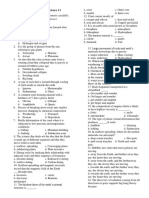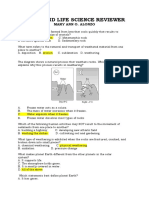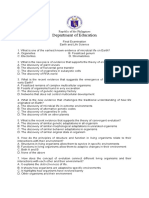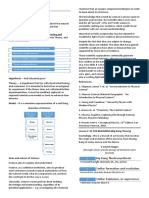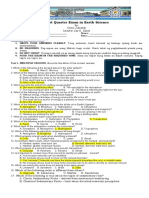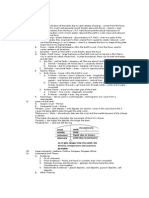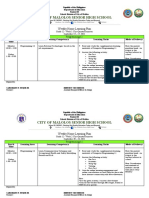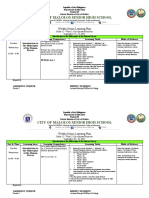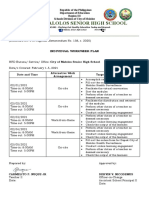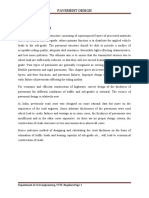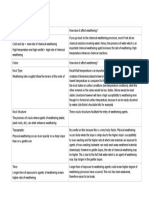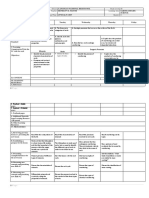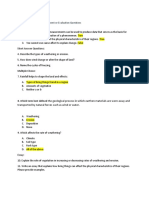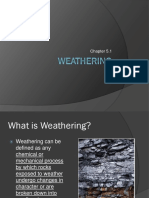Professional Documents
Culture Documents
Earth and Life Science Pre-Test
Earth and Life Science Pre-Test
Uploaded by
Carmelito Nuque Jr0 ratings0% found this document useful (0 votes)
421 views2 pages1. The document is a multiple choice test with 50 questions about various topics in science.
2. The questions cover topics like the solar system, geology, biology, human anatomy and physiology, botany, and evolution.
3. Many of the questions test knowledge of key scientific concepts, theories, models, systems, and terms within these subject areas.
Original Description:
Original Title
Earth and Life Science Pre-test
Copyright
© © All Rights Reserved
Available Formats
DOCX, PDF, TXT or read online from Scribd
Share this document
Did you find this document useful?
Is this content inappropriate?
Report this Document1. The document is a multiple choice test with 50 questions about various topics in science.
2. The questions cover topics like the solar system, geology, biology, human anatomy and physiology, botany, and evolution.
3. Many of the questions test knowledge of key scientific concepts, theories, models, systems, and terms within these subject areas.
Copyright:
© All Rights Reserved
Available Formats
Download as DOCX, PDF, TXT or read online from Scribd
Download as docx, pdf, or txt
0 ratings0% found this document useful (0 votes)
421 views2 pagesEarth and Life Science Pre-Test
Earth and Life Science Pre-Test
Uploaded by
Carmelito Nuque Jr1. The document is a multiple choice test with 50 questions about various topics in science.
2. The questions cover topics like the solar system, geology, biology, human anatomy and physiology, botany, and evolution.
3. Many of the questions test knowledge of key scientific concepts, theories, models, systems, and terms within these subject areas.
Copyright:
© All Rights Reserved
Available Formats
Download as DOCX, PDF, TXT or read online from Scribd
Download as docx, pdf, or txt
You are on page 1of 2
Encircle the letter of the correct answer.
1. It refers to all existing matter and space considered as a whole.
a. Universe b. Galaxy c. Solar system d. Milky way
2. According to this theory, matter is present in the beginning of time.
a. Big-bang Theory b. Planetisimal Theory c. Primordial Theory d. Gravitational Theory
3. It is a representation of idea, an object, or even processes that is used to describe and explain phenomena that
cannot be experienced directly.
a. Model b. Orbit c. Hypothesis d. a and b
4. States that the Earth is at the center of the Solar System
a. Geocentric model b. Heliocentric model c. a and b d. none of the choices
5. He proposed that the Eath is at the center of the Solar System.
a. Cladius Ptolemy b. Isaac Newton c. Robert Wilson d. Immanuel Khant
6. It is the totality of the Earth’s water including the permanently frozen part.
a. Geosphere b. Biosphere c. Hydrosphere d. Athmosphere
7. It refers to the solid Earth.
a. Geosphere b. Biosphere c. Hydrosphere d. Athmosphere
8. Which of the following is not include in the subsystem of Earth.
a.Geosphere b. Biosphere c. Hydrosphere d. Ionosphere
9. It is naturally-occurring aggregate or combination of minerals or mineralloids, such as fossils and glass
a. Minerals b. Rocks c. crystalline d. clastic
10. These rocks are formed through the cooling of magma or lava.
a. Igneous b. sedimentary c. Metamorphic d. all of the choices
11. The following are the properties of minerals except…
a. Luster b. color c. stock d. cleavage
12. It is the general term applied to the combined action of all processes that cause rock to disintegrate physically
and decomposed chemically because of exposure on or near Earth’s surface.
a. Erosion b. Weathering c. a and b d. none of the choices
13. It refers to the downslope movement of rock and soil under the influence of gravity
a. Mass Wasting b. Soil erosion c. Chemical weathering d. Physical weathering
14. It is the method of measuring the absolute age of an event or object.
a. Absolute dating b. Half-life c. Radiometric dating d. a and c
15. It is the remnant of any ancient animal or plant that has been preserved in crystalized rocks.
a. Mummifications b. Superposition c. Fossil d. a and c
16. These are the dangers posed by earthquakes, earthquake-induced by landslide, volcanic eruption and tsunamis.
a. Chemical hazard b. Natural hazard c. Geologic hazard d. Physical hazard
17. It is the consistent reversal of wind system generated by large weather systems affecting a large area.
a. Tides b. Monsoon c. Habagat d. b and c
18. Which of the following is not an effect of seismic or volcanic activity?
a. Tsunami b. Moonsson c. Landslide d. Earthquake
19. They issues public weather forecasts and advisories called public storm warning signal to provide weather
related condition.
a. PSWS b. PAGASA c. NOAH d. PAR
20. Science that deals with structures, functions, and relationships of living things and their environment.
a. Biology b. Microbiology c. Botany d. Zoology
21. The process of converting food molecules to harness energy is called ________.
a. Metabolism b. photosynthesis c. natural selection d. cellular respiration
22. It is the beliefs that life originates from pre-existing life.
a. Biogenesis b. Biodiversity c. Biogenetics d. Biosysthesis
23. Brach of biology that deals with the study of structures and parts of an organism
a. Taxonomy b. Anatomy c. Cytology d. Physiology
24. Study of heredity and variation
a. Cytology b. Ecology c. Genetics d. Genes
25. The idea the frog arise from mud is an example of _________.
a. biogenesis b. panspermia c. spontaneous generation d. divine creation
26. The ability of organisms to respond to stimuli is called ______
a. adaptability b. growth c. irritability d. movement
27. The production of orchids by cutting is an example of _______
a. biogenesis b. abaiogenesis c. devine creation d. spontaneous origin
28. The process where by an animal contains both ovaries and testes, and thus can produce both egg cells and
sperm cells is __________
a. Budding b. fission c. hermaphroditism d. parthenogenesis
29. During germination, the first to appear from the seed is the ____________
a. leaf b. root c. shoot d. stem
30. Sexual reproduction in flowering plants requires ____________
a. bulbs b. pollens c. rhizomes d. tubers
31. They are the plant eating animals.
a. omnivores b. carnivores c. herbivores d. none of the choices
32. There are four types of tissues found in animals. They are the epithelial, connective, muscular and _________.
a. Melanin b. skin c. nervous d. skeletal
33. It is the mechanical and chemical breakdown of food molecules into soluble and diffusible molecules that can be
absorbed by the body cells.
a. ingestion b. digestion c. absorption d. elimination
34. It is the passing of materials that were not absorbed in the large intestine out of the body.
a. ingestion b. digestion c. absorption d. elimination
35. It is how the body gets oxygen and gets rid of carbon dioxide.
a. respiration b. breathing c. a and b d. none of the choices
36. Allows the body to respond appropriately to the information gathered by the sense organ.
a. Endocrine system b. Excretory system c. Respiratory system d. Nervous system
37. It collects wastes produced by cells for elimination.
a. Endocrine system b. Excretory system c. Respiratory system d. Nervous system
38. It breaks down food into molecular form for body cells to use.
a. Digestive system b. Nervous system c. Integumentary system d. Respiratory system
39. The followings t are the levels of organization in an animal body except……
a. cell b. tissues c. organs and organ system d. none of the choices
40. Tissues that connect bones to other bones are called ___________
a. cartilages b. ligaments c. periosteum d. spongy bones
41. The internal skeletal support of animals made of hardened tissues is called the _______.
a. exoskeleton b. endoskeleton c. axial skeleton d. hydrostatic skeleton
42. It conducts water, minerals, sugars and amino acids.
a. non-vascular tissues b. roots c. vascular tissues d. dermal tissues
43. Plants excrete their waste via the ________.
a. parenchyma cells b. companion cells c. guard cells d. stomata
44. It controls the opening and closing of stomata.
a. parenchyma cells b. companion cells c. guard cells d. stomata
45. It covers and protects the surface of the different plant organs.
a. surface b. dermal tissue c. tracheids d. a and b
46. It is the change in populations of organism over time.
a. extinction b. divergent c. convergent d. evolution
47. It is the splitting of a population into two reproductively isolated groups.
a. extinction b. divergent evolution c. convergent evolution d. evolution
48. Which of the following disciplines refer to the native distribution of living species?
a. migration b. paleontology c. biogeography d. continental drift
49. The scientist who arrived at the same conclusion as Darwin is _______
a. Lamarck b. Leclerc c. Plato d. Wallace
50. It is a group of organisms sharing the same characteristics, can mate and can produce their fertile offspring.
a. species b. biomes c. population d. symbiosis
You might also like
- Physical Science Final Exam Review - 2018Document22 pagesPhysical Science Final Exam Review - 2018api-263282807No ratings yet
- Earth and Life Science Exam Prelim - FinalDocument14 pagesEarth and Life Science Exam Prelim - Finalrichardsamrano100% (2)
- Answer Key Grade Six: Weathering and Erosion: Multiple Choice: (4 Points Each)Document5 pagesAnswer Key Grade Six: Weathering and Erosion: Multiple Choice: (4 Points Each)emmanuel richardNo ratings yet
- Pretest Second QuarterDocument2 pagesPretest Second QuarterJobelle Tabinas100% (1)
- NAT Earth LifeScienceDocument11 pagesNAT Earth LifeScienceArnel LomocsoNo ratings yet
- Earth and Life PRETESTDocument2 pagesEarth and Life PRETESTDanico Balasa Coruno100% (1)
- Earth and Life ScienceDocument10 pagesEarth and Life Sciencems.A 1993No ratings yet
- ELS&EsP7 - 1st Periodical TestDocument4 pagesELS&EsP7 - 1st Periodical TestCindy ManipolNo ratings yet
- First Quarter Exam in Earth and Life ScienceDocument4 pagesFirst Quarter Exam in Earth and Life ScienceMr-Butay IntanoNo ratings yet
- Summative Exam in Earth and Life Science - 11 - Esther - Google FormsDocument11 pagesSummative Exam in Earth and Life Science - 11 - Esther - Google FormsLeonard GuevarraNo ratings yet
- Grade 11 Exam - Sci11Document2 pagesGrade 11 Exam - Sci11Aljun Padios100% (1)
- 2nd-Earth and Life ScienceDocument4 pages2nd-Earth and Life ScienceBongskie escalona100% (1)
- 3rd Quarter Exam in PhySciDocument4 pages3rd Quarter Exam in PhySciyvette100% (1)
- Earth and Life Science ReviewerDocument5 pagesEarth and Life Science ReviewerIanaNo ratings yet
- Assessment Earth and Life ScienceDocument4 pagesAssessment Earth and Life ScienceMitz Villaruz-FernandezNo ratings yet
- Holy Child Montessori School of Bulacan Inc. 3 Quarterly Test Physical ScienceDocument5 pagesHoly Child Montessori School of Bulacan Inc. 3 Quarterly Test Physical ScienceDivina NicolasNo ratings yet
- Midterm Exam EarthDocument5 pagesMidterm Exam EarthMarilyn RonquilloNo ratings yet
- Agusan Del Sur National High SchoolDocument4 pagesAgusan Del Sur National High SchoolMark Joseph Serafica AriolaNo ratings yet
- Final Examination EARTH and LIFE SCIENCE With Answer Key 232323Document8 pagesFinal Examination EARTH and LIFE SCIENCE With Answer Key 232323Richard TiempoNo ratings yet
- Grade-12 Stem: Summative Assessment in General Chemistry 1 Multiple ChoiceDocument6 pagesGrade-12 Stem: Summative Assessment in General Chemistry 1 Multiple ChoiceChona CalveloNo ratings yet
- Midterm Earth SciDocument2 pagesMidterm Earth SciPablo Ragay Jr100% (1)
- Why Earth Is HabitableDocument26 pagesWhy Earth Is Habitablestormfury150% (2)
- Limiting Reactants & %yieldDocument21 pagesLimiting Reactants & %yieldviciousNo ratings yet
- Earth Science NotesDocument22 pagesEarth Science NotesMakapikon NagudNo ratings yet
- First Quarter Examination: Space Provided Before Each NumberDocument4 pagesFirst Quarter Examination: Space Provided Before Each NumberMa. Diana ConadoNo ratings yet
- Earth Science Reviewer Grade 11Document10 pagesEarth Science Reviewer Grade 11Maven Cuenca100% (1)
- Final Exam BiologyDocument15 pagesFinal Exam BiologyVlad Vizconde100% (1)
- Summative TestDocument4 pagesSummative TestJaysonEscatronPaguilaNo ratings yet
- Earth Science Final Exam Review SheetDocument2 pagesEarth Science Final Exam Review SheetSteven Brian Bufford Jr.No ratings yet
- Earth Science-1st QuarterDocument4 pagesEarth Science-1st QuarterLhester Jay SalaoNo ratings yet
- 2 Earth and Life ScienceDocument28 pages2 Earth and Life ScienceAmy VillaNo ratings yet
- Earth Science HandoutsDocument7 pagesEarth Science HandoutsAnnie VelasquezNo ratings yet
- Name: - Score: - Grade & Section: - DateDocument4 pagesName: - Score: - Grade & Section: - DateMichelle Ramirez Co-Gonzales100% (1)
- FIRST QUARTER EXAMNATION - Earth SciDocument5 pagesFIRST QUARTER EXAMNATION - Earth SciMela VelaNo ratings yet
- Lesson 1 - Theories On The Origin of The UniverseDocument21 pagesLesson 1 - Theories On The Origin of The UniverseBelle SevillenoNo ratings yet
- Earth Science Reviewer Quarter 2Document6 pagesEarth Science Reviewer Quarter 2Windy Kyle LimNo ratings yet
- Jlssprimer2019 PDFDocument16 pagesJlssprimer2019 PDFJames GalosNo ratings yet
- Direction: Read The Following Statement Carefully. Encircle The Letter of The Correct AnswerDocument8 pagesDirection: Read The Following Statement Carefully. Encircle The Letter of The Correct AnswerPaul Senen DiduloNo ratings yet
- 2ND QUARTER 4th SUMMATIVE TEST EARTH AND LIFE SCIENCE.Document5 pages2ND QUARTER 4th SUMMATIVE TEST EARTH AND LIFE SCIENCE.Jed Jimenez-SinsuanNo ratings yet
- Earth and Life ScienceDocument19 pagesEarth and Life ScienceLj Santos Deuna100% (2)
- Earth Science ReviewerDocument2 pagesEarth Science ReviewerMaestro Pisika Lpt100% (2)
- 1st QTR Exam - Earth & LifeDocument4 pages1st QTR Exam - Earth & LifeBenson CornejaNo ratings yet
- Prelim - Phy Scie11Document3 pagesPrelim - Phy Scie11JaenicaPaulineCristobalNo ratings yet
- General Education ScienceDocument9 pagesGeneral Education ScienceRonnel ManilingNo ratings yet
- MIDTERM EXAMINATION in EARTH SCIENCEDocument3 pagesMIDTERM EXAMINATION in EARTH SCIENCELeonel MendozaNo ratings yet
- CompleteDocument7 pagesCompleteJasmine MendozaNo ratings yet
- Reviewer PSDocument7 pagesReviewer PSJeegj Ecco MedinaNo ratings yet
- Origin of The Universe PPT Earth and Life ScienceDocument33 pagesOrigin of The Universe PPT Earth and Life ScienceCarlos TuazonNo ratings yet
- Earth and Life Science - 2ndqtrexamDocument6 pagesEarth and Life Science - 2ndqtrexamMa. Lourdes LazaroNo ratings yet
- SHS ELS Q1 M3 Minerals-and-RocksDocument23 pagesSHS ELS Q1 M3 Minerals-and-RocksTrisha DiohenNo ratings yet
- MetamorphismDocument31 pagesMetamorphismAngela Ampoloquio100% (1)
- Summative Test in Earth and Life Science Multiple Choice: Read and Answer The Following Questions. Write Your Answer Before The NumberDocument6 pagesSummative Test in Earth and Life Science Multiple Choice: Read and Answer The Following Questions. Write Your Answer Before The NumberGlenda AstodilloNo ratings yet
- Second Quarter Exam Earth and Life SciencesDocument4 pagesSecond Quarter Exam Earth and Life SciencespudoydoyNo ratings yet
- Origin of ElementsDocument27 pagesOrigin of ElementsJoanna Ruth SeproNo ratings yet
- 1st Quarterly Examination-Earth-and-Life-Science-2022-2023Document7 pages1st Quarterly Examination-Earth-and-Life-Science-2022-2023Maryjul Ramos Ranay100% (4)
- Earth and Life Science TOS Test Paper With AnswerDocument5 pagesEarth and Life Science TOS Test Paper With AnswerRussiel Dagohoy100% (3)
- Earth and Life Science Module 1 PDFDocument9 pagesEarth and Life Science Module 1 PDFMhario MaurerNo ratings yet
- Empowerment Technology Topic Summary For QuizDocument2 pagesEmpowerment Technology Topic Summary For QuizAngelo DiyNo ratings yet
- Earth & Life Science Week 1Document7 pagesEarth & Life Science Week 1Justine Evasco RubiaNo ratings yet
- Earth and Life Science Diagnostic ExamDocument3 pagesEarth and Life Science Diagnostic ExamJohn Mark Jarencio100% (1)
- Earth and Life Science General QuizDocument12 pagesEarth and Life Science General QuizLester troy CuerdoNo ratings yet
- Narrative Report - Lac Session (CPN)Document3 pagesNarrative Report - Lac Session (CPN)Carmelito Nuque Jr100% (1)
- Narrative Report On Virtual Recognition Day 3rd QuarterDocument3 pagesNarrative Report On Virtual Recognition Day 3rd QuarterCarmelito Nuque Jr100% (2)
- City of Malolos Senior High School: Weekly Home Learning PlanDocument8 pagesCity of Malolos Senior High School: Weekly Home Learning PlanCarmelito Nuque JrNo ratings yet
- Folic Acid NarrativeDocument1 pageFolic Acid NarrativeCarmelito Nuque JrNo ratings yet
- WHLP - Programming12 2021Document8 pagesWHLP - Programming12 2021Carmelito Nuque JrNo ratings yet
- Narrative Report On Microsoft WebinarDocument3 pagesNarrative Report On Microsoft WebinarCarmelito Nuque JrNo ratings yet
- WHLP - Philo 2021Document8 pagesWHLP - Philo 2021Carmelito Nuque JrNo ratings yet
- City of Malolos Senior High School: School ID: 345345 - Fleshing Out Quality Education Today and BeyondDocument2 pagesCity of Malolos Senior High School: School ID: 345345 - Fleshing Out Quality Education Today and BeyondCarmelito Nuque JrNo ratings yet
- OKsa DepEd FinalsDocument9 pagesOKsa DepEd FinalsCarmelito Nuque JrNo ratings yet
- Action Plan For Barkada Kontra DrogaDocument1 pageAction Plan For Barkada Kontra DrogaCarmelito Nuque JrNo ratings yet
- City of Malolos Senior High School: School ID: 345345 - Fleshing Out Quality Education Today and BeyondDocument2 pagesCity of Malolos Senior High School: School ID: 345345 - Fleshing Out Quality Education Today and BeyondCarmelito Nuque JrNo ratings yet
- City of Malolos Senior High School: Individual Workweek PlanDocument1 pageCity of Malolos Senior High School: Individual Workweek PlanCarmelito Nuque JrNo ratings yet
- City of Malolos Senior High School: Entrepreneurial CompetenciesDocument3 pagesCity of Malolos Senior High School: Entrepreneurial CompetenciesCarmelito Nuque JrNo ratings yet
- 1stQ Programming 11Document4 pages1stQ Programming 11Carmelito Nuque JrNo ratings yet
- WHLP - 2Q Week4 All SubjectDocument6 pagesWHLP - 2Q Week4 All SubjectCarmelito Nuque JrNo ratings yet
- City of Malolos Senior High School: Individual Workweek PlanDocument2 pagesCity of Malolos Senior High School: Individual Workweek PlanCarmelito Nuque JrNo ratings yet
- City of Malolos Senior High School: Entrepreneurial CompetenciesDocument3 pagesCity of Malolos Senior High School: Entrepreneurial CompetenciesCarmelito Nuque JrNo ratings yet
- 1stQ Earth and Life ScienceDocument3 pages1stQ Earth and Life ScienceCarmelito Nuque Jr0% (1)
- Long Quiz ELSDocument2 pagesLong Quiz ELSCarmelito Nuque JrNo ratings yet
- Module 5 - Part 1 (Ce 361 - Advanced Concrete Technology)Document13 pagesModule 5 - Part 1 (Ce 361 - Advanced Concrete Technology)lakshmi dileepNo ratings yet
- Tugas Mandiri Selama US KLS X IPA-IPSDocument17 pagesTugas Mandiri Selama US KLS X IPA-IPSDzakwan DhiyaNo ratings yet
- Primary and Secondary Geochemical Dispersion PatternsDocument2 pagesPrimary and Secondary Geochemical Dispersion PatternsTREVOR MAVUNGANo ratings yet
- Pavement Design Seminar ReportDocument27 pagesPavement Design Seminar ReportRenuka Talwar100% (2)
- Geologic Process (Endo and Exo)Document37 pagesGeologic Process (Endo and Exo)Kimberly Hosmillo ImperialNo ratings yet
- Fundamentals of Fracture MechanicsDocument22 pagesFundamentals of Fracture MechanicsRino NelsonNo ratings yet
- Proceedings: 9 - 11 September 2002 Perth, AustraliaDocument12 pagesProceedings: 9 - 11 September 2002 Perth, AustraliaRBVGEONo ratings yet
- Classification of Rock Material Weathering GradesDocument1 pageClassification of Rock Material Weathering Gradesalex_kia100% (4)
- Factors That Affect WeatheringDocument1 pageFactors That Affect WeatheringJing RN LptNo ratings yet
- Astm E1820Document48 pagesAstm E1820dddNo ratings yet
- DLL Template Wk3Document6 pagesDLL Template Wk3Reign MayorNo ratings yet
- Earth and Life ScienceDocument79 pagesEarth and Life ScienceKimberly Punzalan Burgos100% (1)
- Notch Effects in Fatigue and FractureDocument360 pagesNotch Effects in Fatigue and Fractureghontajit09No ratings yet
- Powerpoint CHAPTER 4 - WEATHERINGDocument69 pagesPowerpoint CHAPTER 4 - WEATHERINGThevhan MurallyNo ratings yet
- 2014.barton, N. and Grimstad, E. An Illustrated Guide To The Q-System PDFDocument44 pages2014.barton, N. and Grimstad, E. An Illustrated Guide To The Q-System PDFjesuscastillo82100% (2)
- Structural LandformsDocument267 pagesStructural Landformsgeoecologist100% (1)
- Weathering: Shiella Marie A. Ganiban, Mt-Ii Subject TeacherDocument48 pagesWeathering: Shiella Marie A. Ganiban, Mt-Ii Subject TeacherMadelyn ConcepsionNo ratings yet
- Summative Test Earth and Life Science Module 1: NAME: - GRADE & SECTIONDocument8 pagesSummative Test Earth and Life Science Module 1: NAME: - GRADE & SECTIONMira Lei MarigmenNo ratings yet
- Natural Resource 1Document10 pagesNatural Resource 1Chude KerrNo ratings yet
- Assessment or Evaluation Questions-2-2Document2 pagesAssessment or Evaluation Questions-2-2api-549067802No ratings yet
- Earth and Life Science: Quarter 1 - Module 5: Exogenic ProcessesDocument24 pagesEarth and Life Science: Quarter 1 - Module 5: Exogenic Processeshara azurNo ratings yet
- Chemical Weathering of Lime Mortars From The Jahan PDFDocument10 pagesChemical Weathering of Lime Mortars From The Jahan PDFNida AtifNo ratings yet
- Soil ScienceDocument70 pagesSoil Sciencegame nextNo ratings yet
- Geography of Ethiopia and The HornDocument139 pagesGeography of Ethiopia and The HornhendekegetachewNo ratings yet
- UNIT-2 Serviceability and Durability of ConcreteDocument16 pagesUNIT-2 Serviceability and Durability of Concreteapi-297121029No ratings yet
- Plastic RoadsDocument24 pagesPlastic RoadsGnaneshwar DevarapagaNo ratings yet
- Weathering and ErosionDocument17 pagesWeathering and ErosionArnav HandeNo ratings yet
- The National Academies Press: Recommended Practice For Stabilization of Subgrade Soils and Base MaterialsDocument67 pagesThe National Academies Press: Recommended Practice For Stabilization of Subgrade Soils and Base MaterialsfranspratamastNo ratings yet
- Module 4 HIgh Cycle and Low Cycle FatigueDocument21 pagesModule 4 HIgh Cycle and Low Cycle FatiguerohanNo ratings yet








